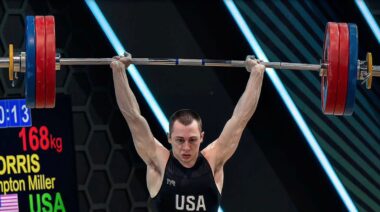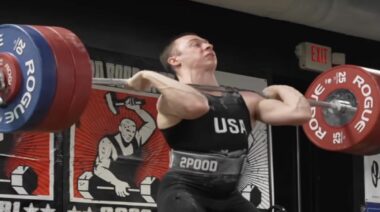A common issue encountered in training female weightlifters is that of body image, and more specifically, bodyweight. In our modern, mass-media controlled culture, both males and females are bombarded from pre-adolescence with supposedly desirable body images. For girls, the ideal is all too frequently the appearance of a fashion model. But what does that appearance have to do with a woman who can lift?
A common issue encountered in training female weightlifters is that of body image, and more specifically, bodyweight. In our modern, mass-media controlled culture, both males and females are bombarded from pre-adolescence with supposedly desirable body images. For girls, the ideal is all too frequently the appearance of a fashion model. But what does that appearance have to do with a woman who can lift?
Care more about the weight on the bar than the weight on your body. [Photo credit: Bruce Klemens/Breaking Muscle]
Your Body Will Look Like What It Can Do
What everyone needs to understand is that an athlete looks like whatever she is. If you are a highly-trained athlete with a specialized lifestyle, the functions you perform will dictate the form that your body takes.
I previously wrote about Diana Fuhrman, one of the pioneers of women’s weightlifting in the United States. Since it was a relatively new sport, few people had any idea of what a female weightlifter might look like. All too frequently, when Diana was introduced as an elite weightlifter, the response was “you don’t look like a weightlifter.” What they actually meant that she didn’t look like a bodybuilder.
When people are given the chance to express their ignorance, many will enthusiastically take it.
For several years, Diana competed at 56kg and 60kg. I knew that in order for her to lift at her maximal capacity, she would need to gain weight. Her height was 5ft 4in, and weighing 132lb would not allow her to carry enough muscle to clean and jerk competitive weights. We had many discussions regarding her bodyweight over the years. She was hesitant to go against the societal norms for bodyweight at her height. After failing to make progress over several meets, she finally decided to go up to 67.5kg and it was there that she did her best lifting. By her retirement, she had set the American records with a 93kg snatch and 115kg clean and jerk.
Limbs work as a lever system, and the longer the lever, the more force must be generated to move that limb. At a certain point, more force can only be generated by more muscle mass. Consequently, the taller the weightlifter, the more muscle mass will be needed to move the longer limbs against resistance.
Supermodels Can’t Clean and Jerk
Successful weightlifters will have a certain appearance that is the result of the preparation necessary to achieve excellent results in the sport. This may conflict with popular ideals of feminine morphology. But then again, so also do the physiques of many channel swimmers, basketball players, gymnasts, and athletes from other sports that require extreme specialization.
For perspective, below is a table that I published in my book Weightlifting Programming. The data was compiled by Leslie Musser, one of my former lifters, for her Masters thesis, at the 2009 Pan American weightlifting championships. It provides a snapshot of the bodyweight-to-height ratio of elite level female weightlifters.
| Weight Class | Minimum | Maximum | Mean | Std. Deviation |
|---|---|---|---|---|
| 48kg (105lb) | 4ft 6.7in | 5ft | 4ft 10.3in | 1.95in |
| 53kg (116lb) | 4ft 10.7in | 5ft 1.2in | 5ft | 1.08in |
| 58kg (127lb) | 4ft 11.3in | 5ft 2.6in | 5ft 0.7in | 1.21in |
| 63kg (138lb) | 4ft 11in | 5ft 3.8in | 5ft 1.9in | 1.80in |
| 69kg (152lb) | 5ft | 5ft 4.6in | 5ft 2.4in | 1.57in |
| 75kg (165lb) | 5ft 2.6in | 5ft 5.9in | 5ft 4.2in | 1.43in |
Women who aspire to reach the elite levels of weightlifting competition must realize that they will likely exceed the bodyweight-to-height ratios of supermodels. Those who become addicted to the sport at any level will learn to deal with the truth of the data.
So what is your ideal weight class, anyway?






